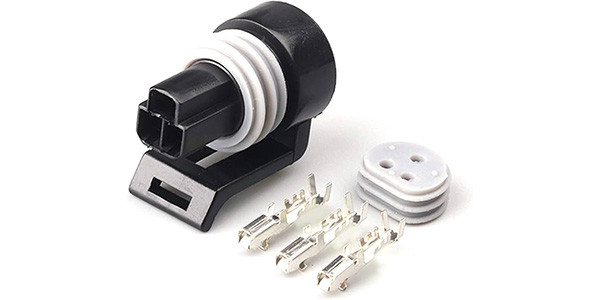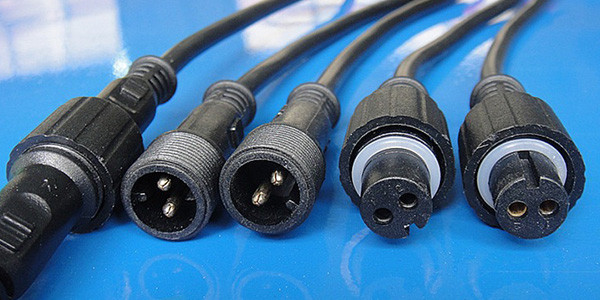Automotive Oil-Resistant Connectors
Ensuring Reliability in Harsh Environments
Automotive Oil-Resistant Connectors: Ensuring Reliability in Harsh Environments

Automotive oil-resistant connectors are specialized components engineered to maintain reliable electrical connections in vehicles despite exposure to oil and other fluids. As modern vehicles grow increasingly complex, with intricate electrical systems powering everything from engine management to advanced driver-assistance systems (ADAS), the demand for durable, high-performance connectors has never been greater.
Table of Contents
ToggleIntroduction to Automotive Connectors
The Backbone of Vehicle Electrical Systems
Automotive connectors are essential components that facilitate electrical connections across a vehicle’s myriad systems. From powering headlights and infotainment displays to linking sensors and control units in the engine compartment, connectors ensure seamless communication and functionality. In a modern car, thousands of electrical connections work in harmony, making connectors the backbone of vehicle performance.
The Rise of Electrical Complexity
Over the past few decades, vehicles have evolved from mechanical marvels to sophisticated electronic ecosystems. The average car today contains over 100 electronic control units (ECUs), countless sensors, and miles of wiring—all reliant on connectors to function. This complexity amplifies the importance of reliability, as a single faulty connection can disrupt critical systems, from braking to fuel injection.
Challenges in the Automotive Environment
Connectors in vehicles face a gauntlet of harsh conditions: extreme temperatures ranging from frigid winters to scorching engine bays, constant vibration from road travel, moisture from rain or humidity, and exposure to chemicals like oil, fuel, and coolant. Among these, oil poses a unique threat, especially in areas like the engine and transmission, where leaks or splashes are common. Standard connectors can degrade under such exposure, leading to failures that compromise safety and performance.
Enter Oil-Resistant Connectors
This is where automotive oil-resistant connectors shine. Designed to withstand oil exposure without sacrificing electrical integrity, these connectors are vital for ensuring long-term reliability in fluid-prone environments. Whether in a gasoline-powered car or an electric vehicle (EV) with cooling fluids, oil-resistant connectors provide a robust solution to one of the automotive industry’s toughest challenges.
The Need for Oil-Resistant Connectors
Oil Exposure in Automotive Environments
Vehicles are dynamic systems where fluids like oil, fuel, and coolant are omnipresent. In the engine compartment, oil leaks from seals or gaskets can drip onto nearby connectors. Transmission systems, with their intricate gearing and lubrication, pose similar risks. Even during routine maintenance, accidental spills can coat connectors in oil. These scenarios highlight the inevitability of fluid exposure in automotive applications.

The Consequences of Oil on Standard Connectors
Oil is a formidable adversary for electrical connectors. When it penetrates a standard connector’s housing, it can wreak havoc in several ways:
- Degradation: Oil can soften or break down plastic and rubber components, compromising the connector’s structure.
- Corrosion: It can infiltrate metal contacts, leading to rust or oxidation that disrupts electrical conductivity.
- Short Circuits: Oil accumulation can bridge electrical paths, causing shorts that damage systems or trigger malfunctions.
- Increased Resistance: Contamination on contacts can elevate resistance, reducing signal quality and power delivery.
Imagine leaving a plastic toy in a puddle of oil—it might soften, discolor, or crack over time. Similarly, unprotected connectors succumb to oil’s destructive effects, potentially leading to engine misfires, sensor failures, or even complete system shutdowns.
Why Oil Resistance Matters
Oil-resistant connectors address these risks head-on. By preventing oil ingress and material breakdown, they ensure consistent performance, even in the harshest conditions. This reliability translates to fewer repairs, enhanced safety, and extended vehicle lifespan—benefits that resonate with manufacturers, mechanics, and drivers alike.
3. Materials Used in Oil-Resistant Connectors
Key Properties for Oil Resistance
The materials in oil-resistant connectors must possess specific traits to combat oil’s effects. These include:
- Chemical Resistance: The ability to withstand hydrocarbons without swelling, cracking, or degrading.
- Mechanical Stability: Maintaining strength and flexibility under prolonged exposure.
- Temperature Tolerance: Performing reliably in the wide temperature ranges of automotive environments.
Common Materials and Their Advantages
Several materials have proven effective in oil-resistant connectors, each offering unique benefits:
Fluorosilicone
- Properties: Exceptional resistance to oils, fuels, and solvents, paired with excellent high-temperature performance (up to 200°C or more).
- Advantages: Ideal for engine compartments and fuel systems where extreme conditions prevail.
- Applications: Often used in seals and gaskets within connectors.
Nitrile Rubber (NBR)
- Properties: Good resistance to oils and fuels, with decent flexibility and durability.
- Advantages: Cost-effective and widely available, making it a popular choice for budget-conscious designs.
- Applications: Common in sealing elements and less demanding environments.
Viton (Fluoroelastomer)
- Properties: Superior resistance to oils, chemicals, and temperatures (up to 250°C), with minimal degradation over time.
- Advantages: Offers premium performance in critical applications where reliability is non-negotiable.
- Applications: Found in high-end connectors near engines and transmissions.
Polyamide (Nylon)
- Properties: Certain grades provide oil resistance, combined with strength and moldability.
- Advantages: Lightweight and versatile, suitable for connector housings.
- Applications: Used in structural components exposed to moderate oil levels.
Material Selection Factors
Choosing the right material depends on the application. For instance, Viton might be preferred in a high-temperature engine bay, while NBR suffices for a lower-cost transmission connector. Engineers balance performance, cost, and environmental demands to optimize connector design.
Design Considerations for Oil-Resistant Connectors
Beyond Materials: The Role of Design
While materials provide the foundation, the design of oil-resistant connectors is equally critical. A well-engineered connector prevents oil ingress and maintains functionality through thoughtful features.
Sealing Mechanisms
- Gaskets and O-Rings: These create tight barriers between connector halves, blocking oil entry.
- Integral Seals: Molded directly into the housing, they enhance protection without additional components.
- IP Ratings: Many connectors achieve Ingress Protection ratings (e.g., IP67), ensuring resistance to fluids and dust.
Housing Design
- Robust Construction: Thick, durable housings resist cracking or warping under oil exposure.
- Smooth Surfaces: Minimize areas where oil can pool or penetrate.
- Locking Mechanisms: Secure connections prevent loosening from vibration, maintaining seal integrity.
Contact Design
- Coatings: Gold or nickel plating on contacts reduces corrosion risk if oil seeps in.
- Fluid-Shedding Shapes: Angled or sloped contacts discourage oil accumulation.
- Redundancy: Some designs include multiple contact points to ensure reliability.
Balancing Size and Performance
As vehicles demand smaller, lighter components, designers face the challenge of maintaining oil resistance in compact packages. Innovations like miniaturized seals and advanced molding techniques address this, ensuring connectors remain effective without adding bulk.
Testing and Standards
Ensuring Reliability Through Rigorous Testing
Oil-resistant connectors must prove their mettle through standardized tests that simulate real-world conditions. These tests verify that connectors can endure oil exposure without compromising performance.

Key Industry Standards
- SAE J2030: A widely recognized standard for automotive electrical connectors, it includes fluid resistance requirements.
- ISO 16750: Covers environmental testing for electrical equipment in road vehicles, including oil exposure.
- IEC 60529: Defines IP ratings for ingress protection, relevant to fluid resistance.
Testing Procedures
- Fluid Immersion: Connectors are submerged in oil (e.g., engine oil or transmission fluid) at specified temperatures (often 85°C–150°C) for hours or days.
- Performance Checks: Post-immersion, electrical conductivity, insulation resistance, and mechanical integrity are measured.
- Cycling Tests: Connectors may undergo repeated oil exposure and drying to mimic long-term use.
Certification and Quality Assurance
Only connectors that pass these stringent tests earn certification for automotive use. This ensures they meet the reliability standards demanded by manufacturers and regulators, safeguarding vehicle performance.
Applications of Oil-Resistant Connectors
Where They Shine
Oil-resistant connectors are deployed across vehicles wherever oil exposure is a risk. Here are key examples:
Engine Control Units (ECUs)
- Role: Connect sensors and actuators to the ECU, managing engine performance.
- Need: Oil leaks from the engine can reach these connectors, necessitating resistance.
Transmission Control Modules
- Role: Facilitate communication for gear shifting and torque control.
- Need: Proximity to transmission fluid demands robust oil resistance.
Fuel and Oil Sensors
- Role: Monitor pressure, level, or flow of fluids.
- Need: Direct contact with oil or fuel requires connectors that won’t degrade.
Electric Vehicles (EVs)
- Role: Link cooling systems and battery management units.
- Need: While EVs have less oil, coolants and lubricants still require resistant connectors.
Real-World Impact
In a gasoline car, an oil-resistant connector near the oil pressure sensor might prevent a dashboard warning light from falsely triggering. In an EV, it could ensure a cooling system operates flawlessly, protecting the battery pack.
Future Trends and Developments
Adapting to an Evolving Industry
The automotive landscape is shifting, driven by electrification, autonomy, and connectivity. Oil-resistant connectors are evolving to meet these new demands.
Electric Vehicles (EVs)
- High-Voltage Needs: EV connectors must handle higher voltages while resisting coolants and lubricants.
- Compact Designs: Smaller connectors fit tight spaces in battery packs and motors.
Autonomous Vehicles
- Sensor Proliferation: More sensors for navigation and safety increase connector demand.
- Data Integrity: Reliable connections ensure accurate data transmission in oil-prone areas.
Material Innovations
- Nanotechnology: Coatings that repel oil could enhance resistance.
- Polymer Blends: New composites might offer better performance in smaller sizes.
- Sustainability: Bio-based or recyclable materials align with environmental goals.
Connectivity and IoT
- Data Demands: Connected vehicles require connectors that support high-speed data alongside oil resistance.
- EMC Challenges: Electromagnetic compatibility becomes critical as electronics multiply.
Looking Ahead
As vehicles become smarter and greener, oil-resistant connectors will remain indispensable, adapting to new fluids, designs, and standards while maintaining their core mission of reliability.
Conclusion
The Unsung Heroes
Automotive oil-resistant connectors are vital cogs in the machinery of modern vehicles. By resisting oil’s destructive effects, they ensure electrical systems operate flawlessly, from the engine bay to the dashboard. Their specialized materials, thoughtful designs, and rigorous testing make them indispensable in harsh environments.
Choosing Wisely
Selecting the right connector involves weighing application needs, environmental conditions, and compliance with standards. The investment in quality connectors pays off in reduced failures, lower maintenance costs, and enhanced safety.
A Bright Future
As automotive technology advances, oil-resistant connectors will continue to evolve, supporting electrification, autonomy, and sustainability. Their role in keeping vehicles running smoothly underscores their importance—an importance that will only grow in the years ahead.
